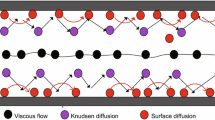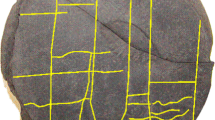Shale gas reservoirs are typical unconventional natural gas resources characterized by low porosity and low permeability of the formation. To enhance production and provide an economically justified production rate, the multi-stage fractured horizontal well (MFHW) technology has been widely used in shale gas reservoirs. More attention has been paid recently to studying the mechanism of multi-scale flow in shale. However, the mechanism of gas seepage in shale in a multi-stage fractured horizontal well has not been systematically discussed. In the previously published conventional studies, the authors have not presented a comprehensive analysis of the adsorption, desorption, and diffusion mechanisms participating in gas seepage, particularly within a linear flow model. In this paper, the linear superposition method is applied to describe the non-Darcy flow behavior in nano/micro-scale pores and the Darcy flow behavior in macropores and natural/induced fractures in a shale matrix. Based on the flow mode, the shale reservoir and the area around the multi-stage fractured horizontal well are divided into three zones: the outer region flow, the inner region flow, and the flow in the hydraulic fractures. Based on the trilinear flow model, the authors consider the differences in properties between the initial shale reservoir and the induced fracture network of the stimulated reservoir volume (SRV). In this model, the dimensionless variables, Duhamel principle, and numerical Stehfest algorithm are combined to analyze the dynamic bottomhole pressure, adsorption-desorption behavior, multi-scale flow mechanism, and complex SRV geometry in the MFHW area. Based on the established model, the effect of the key factors and their influence on the dimensionless pressure and pressure derivate curves are considered..










Similar content being viewed by others
References
S. Wang et al., “Shale gas exploration: Status, problems, and prospect,” Nat. Gas Ind. B., 5(1), 60-74 (2018).
C. D. Jenkins and C. M. Boyer, “Coalbed and shale gas reservoirs,” J. Pet. Technol., 60(2), 92-99 (2008).
H. Sun, J. Yao, S. H. Gao, et al., “Numerical study of CO2 enhanced natural gas recovery and sequestration in shale gas reservoirs,” Int. J. Greenhouse Gas Control, 19, 406-419 (2013).
A. Ghanizadeh et al., “Petrophysical and geomechanical characteristics of Canadian tight oil and liquid-rich gas reservoirs,” Fuel, 153, 664-691 (2016).
D. Liu et al., “Evaluation of the role of water-shale-gas reactions on CO2 enhanced gas recovery,” Energy Proc., 154, 42-47 (2018).
G. Chalmers and R. M. Bustin, “Lower Cretaceous gas shales in northeastern British Columbia, part II: evaluation of regional potential gas resources,” Bull. Can. Pet. Geol., 56(1), 22-61 (2008).
D. J. K. Ross and R. M. Bustin, “Impact of mass balance calculations on adsorption capacities in microporous shale gas reservoirs,” Fuel, 86(17-18), 2696-2706 (2007).
L. Chen et al., “Mechanisms of shale gas adsorption: evidence from thermodynamics and kinetics study on methane adsorption on shale,” Chem. Eng. J., 361, 559-570 (2019).
P. D. Schettler, C. R. Parmely, and W. J. Lee, “Gas storage and transport in Devonian Shales,” SPE Form. Eval., 4(3), 371-376 (1986).
G. R. King, “Material-balance techniques for coal seam and Devonian Shale gas reservoirs,” SPE Res. Eng., 8(01), 61-67 (1993).
F. Javadpour, “Nanopores and apparent permeability of gas flow in mudrocks,” J. Can. Pet. Technol., 48(8), 16-21 (2009).
F. Civan, C. S. Rai, and C. Sondergeld, “Shale-gas permeability and diffusivity inferred by improved formulation of relevant retention and transport mechanisms,” Transp. Porous Med., 86, 925-944 (2011).
C. Guo et al., “Study on gas permeability in nanopores of shale gas reservoirs,” SPE 167179, SPE Unconventional Resources Conference, Calgary, Alberta, Canada (2013).
J. F. W. Gale, E. M. Reed, and J. Holder, “Natural fractures in the Barnett Shale and their importance for hydraulic fracture treatment,” AAPG Bull., 91(4), 603-622 (2007).
E. Fathi and Y. Akkutlu, “Matrix heterogeneity effects on gas transport and adsorption in coalbed and shale gas reservoirs,” Transp. Porous Med., 80(2), 281-304 (2009).
J. Guo, L. Zhang, H. Wang, et al., “Pressure transient analysis for multi-stage fractured horizontal wells in shale gas reservoirs,” Transp. Porous Med., 93(3), 635-653 (2012).
S. Du, N. Yoshida, B. Liang, et al., “Application of multi-segment well approach: dynamic modeling of hydraulic fractures,” Nat. Gas Sci. Eng., 34, 886-897 (2016).
X. Hu et al., “A multiscale model for methane transport mechanisms in shale gas reservoirs,” J. Pet. Sci. Eng., 172, 40- 49 (2019).
E. Ozkan and M. Brown, “Comparison of fractured horizontal-well performance in conventional and unconventional reservoirs,” SPE Western Regional Meeting, San Jose, California, USA (2009).
R. O. Bello and R. A. Wattenbarger, “Modeling and analysis of shale gas production with a skin effect,” J. Can. Pet. Technol., 49(12), 37-48 (2010).
R. O. Bello and R. A. Wattenbarger, “Multistage hydraulically fractured shale gas rate transient analysis,” SPE North Africa Technical Conference, Cairo, Egypt (2010).
H. A. Al-Ahmadi and R. A. Wattenbarger, “Application of linear flow analysis to shale gas wells-field cases,” SPE Unconventional Gas Conference, Pittsburgh, Pennsylvania, USA (2010).
E. Stalgorova and M. Louis, “Practical analytical model to simulate production of horizontal wells with branch fractures,” SPE Canadian Unconventional Resources Conference, Calgary, Canada (2012).
S. Ottiger, R. Pini, G. Storti, et al., “Measuring and modeling the competitive adsorption of CO2, CH4, and N2 on a dry coal,” Langmuir, 24(17), 9531-9540 (2008).
S. Mohammad, J. Fitzgerald, R. L. Robinson RL, and K. A. M. Gasem, “Experimental uncertainties in volumetric methods for measuring equilibrium adsorption,” Energy Fuels, 23(5), 2810-2820 (2009).
J. C. Xu, C. H. Guo, M. Z. Wei, et al., “Production performance analysis for composite shale gas reservoir considering multiple transport mechanisms,” J. Nat. Gas Sci. Eng., 26, 382-395 (2015).
NOMENCLATURE
a — desorption coefficient;
b — pseudo-permeability coefficient, dimensionless;
C — molarity of shale gas, kmol/m3;
C — compressibility, MPa–1;
C D — dimensionless wellbore storage coefficient;
D — diffusion coefficient, m2/h;
d — diameter of pore, m;
F CD dimensionless diffusivity of fracture;
F s — shape factor of the matrix, 1/m2;
h — thickness of shale gas reservoir, m;
k — permeability, mD;
Kn — Knudsen number, dimensionless;
M — molecular weight of shale gas, kg/kmol
m — pseudo-pressure;
n — gas molar quantity, kmol;
R o — maturity of organic matter, %;
p — gas pressure, Pa;
\( \overline{p} \) — mean pressure, Pa;
pi — original reservoir pressure, Pa;
pL — Langmuir pressure, Pa;
pD — dimensionless wellbore pressure under constant production rate;
p D ′ — dimensionless wellbore pressure derivative under constant production rate;
p w — wellbore pressure, Pa;
q — production rate, m3/s;
R — gas constant, 8.314·103 Pa×m3/(kmol×K);
R CD — dimensionless fracture conductivity;
s — variable in Laplace-transform domain;
S c — skin factor;
T — temperature, K;
t — time, h;
V — adsorption of gas, m3/kg;
V E — volume concentration of shale gas in the interface of matrix and fracture, m3/m3;
V L — Langmuir volume, m3/kg;
v c — diffusion velocity of gas, m/h;
v p — permeability velocity of gas, m/h;
w F — half-width of the hydraulic fracture, m;
x e — half-length of the reservoir in the x-direction, m;
x F — half-length of the hydraulic fracture, m;
y e — half-space of the hydraulic fracture, m;
Z — compressibility of gas, dimensionless;
x, y, z — cartesian coordinates;
r — cylindrical coordinates.
Greek symbols
η — diffusivity, m2/s;
λ — mean free path of gas in pores, m;
λ — flow capacity ratio, mD/m2;
μ — viscosity of gas, cPs;
ρ — density of shale gas, kg/m3;
ρv — mass velocity, kg/(m2×s);
ρ sc — density of shale gas under standard conditions, kg/m3;
f — porosity, %;
ω — storativity ratio, dimensionless.
Subscripts
D — dimensionless variables;
O — outer zone;
I — inner zone;
F — hydraulic fracture;
f — natural fracture;
i — original variables;
i, j — subscript;
m — matrix system;
sc — standard conditions.
Author information
Authors and Affiliations
Corresponding author
Additional information
Translated from Khimiya i Tekhnologiya Topliv i Masel, No. 6, pp. 62–69, September-October, 2021.
Dimensionless variables
Dimensionless variables
Dimensionless pseudo-pressure:
Dimensionless time:
Dimensionless distance (coordinates):
Dimensionless diffusivities:
Dimensionless fracture conductivity:
The Stehfest method
Rights and permissions
About this article
Cite this article
Wang, Z., Zhang, L., Zhang, R. et al. Flow Mechanism and Transient Pressure Analysis of Multi-Stage Fractured Horizontal Well. Chem Technol Fuels Oils 57, 941–954 (2022). https://doi.org/10.1007/s10553-022-01332-4
Published:
Issue Date:
DOI: https://doi.org/10.1007/s10553-022-01332-4




